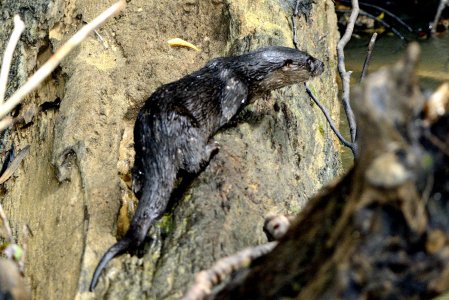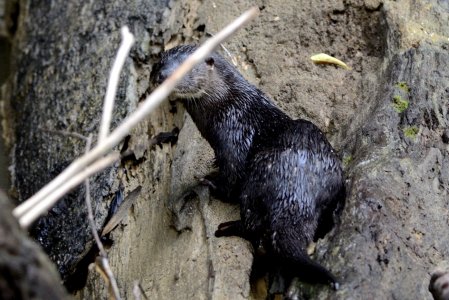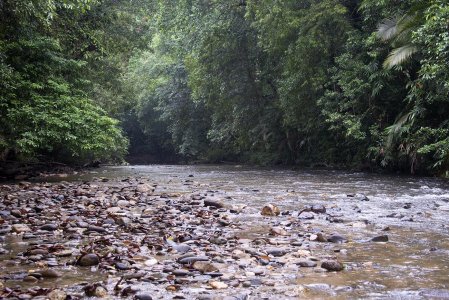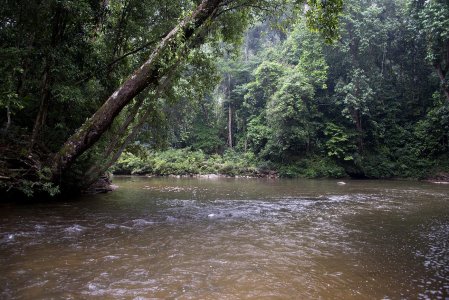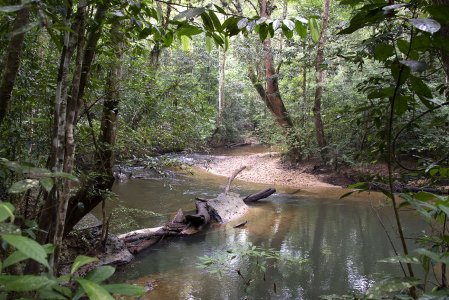IUCN/SSC Otter Specialist Group Bulletin

|
©IUCN/SCC Otter Specialist Group Volume 30 Issue 2 (October 2013) Citation: Baker, N. (2013). New Records of Hairy-Nosed Otter (Lutra sumatrana) in Peninsular Malaysia. IUCN Otter Spec. Group Bull. 30 (2): 112 - 118 New Records of Hairy-Nosed Otter (Lutra sumatrana) in Peninsular Malaysia Nick Baker 1 1Nature enthusiast and photographer, webmaster of amateur website EcologyAsia. Email: nick-baker@ecologyasia.com |

|
| Received 2nd July 2013, accepted 20th October 2013 |
| Abstract:Two sightings of Hairy-nosed Otter (Lutra sumatrana) were made at Sungai Tanum and Sungai Relau, Taman Negara, Pahang, Peninsular Malaysia. These are the third and fourth formally documented records of the species from Peninsular Malaysia since the 1960’s, and the first records from Taman Negara in the same period. |
| Keywords: Taman Negara; Pahang; Sungai Tanum; Sungai Relau; Lutra sumatrana |
| Française | Español | Bahasa Malaysia |
The Hairy-nosed Otter Lutra sumatrana, is a rarely seen animal throughout its range in Southeast Asia. In Peninsular Malaysia, Sebastian (1995) discusses two records of L. sumatrana, both roadkills in areas close to peat swamp forest, one in 1991 in the state of Perak and another in 1994 in the state of Pahang. Sebastian (1995) also states that “L. sumatrana had not been recorded in the peninsula since the sixties”.
Between May 2013 and September 2013 the author made two trips to the western entrance of the protected area of Taman Negara, Peninsular Malaysia, just east of the town of Merapoh. The habitat comprises intact, lowland dipterocarp forest. One otter was seen and photographed on each trip, on 15th May and 10th September. Subsequent review of images from both sightings shows the species to be the Hairy-nosed Otter Lutra sumatrana. Although the diagnostic hairy rhinarium cannot be clearly seen, the pale lips, chin and neck are evident in the photographs. In addition the fur appears somewhat rough, and the head somewhat flattened.
DETAILS OF SIGHTINGS
15th May 2013
On 15th May 2013 the author visited Sungai Tanum (Kuala Juram) (Lat 4 38.751 Long 102 07.941) with two other nature photographers. Kuala Juram is accessible from the western entrance of Taman Negara, just east of Merapoh. The main gate to Taman Negara is 6 km east of Merapoh, and Kuala Juram a further 9.5 km east. Kuala Juram lies at the confluence of two rivers, the smaller Sungai Juram and larger Sungai Tanum. (In Malay, Kuala = Confluence, Sungai = River). See map ( Figure 1 ). The elevation of Kuala Juram is around 190 metres above sea level, based on a GPS fix.
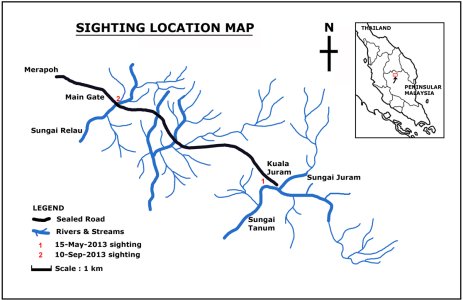
|
| Figure 1. Sighting location map (click for larger version) |
Taman Negara (In Malay, Taman = Park, Negara = Country i.e. National Park) was established in 1938, and is the largest protected area in Peninsular Malaysia. It lies mainly within the state of Pahang and covers more than 4,000 square kilometres.
At 07:58 the author arrived at Sungai Tanum, and set up his camera gear on a rocky sandbank at the edge of the river, and waited for wildlife to appear. The camera equipment comprised a tripod-mounted Nikon D600 DSLR with a 300mm f2.8 lens.
At 09:28 an otter was observed, already fully emerged from the river, quietly exploring the opposite bank of Sungai Tanum: it climbed a few metres up the steeply-sloping river bank, partly hidden by vegetation, and inspected some cavities beneath large tree roots. The otter then slipped back into the water.
At 09:29 the otter reappeared on the same side of Sungai Tanum as the author, about 25 metres downstream: it briefly emerged from beneath some floating debris (tree branches, small tree trunks) which had accumulated at the edge of the river.
At 09:30 the otter appeared for a third time beneath a large fallen tree around 50 metres downstream from the author: its head and neck were out of the water and it was closely inspecting the river bank beneath the fallen tree ( Fig 2 ). Seconds later the otter swam beneath the water. The author waited for another 30 minutes but the otter did not reappear.
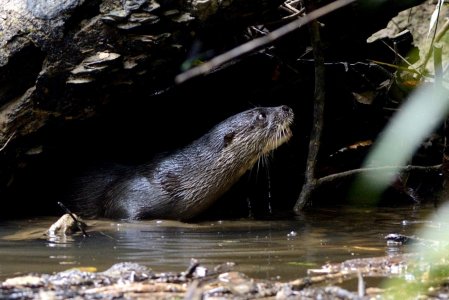
|
| Figure 2. L. sumatrana at Sungai Tanum inspecting area beneath fallen tree. (click for larger version) |
River conditions on that morning appeared ‘normal’: the water was relatively clear, and sandbanks and gravel banks were visible. A storm the previous night had not caused water levels to rise significantly. Weather conditions were cool but dry.
10th September 2013
On 10th September 2013 another trip was made to Taman Negara with two more nature photographers. At 17:30 a lone Hairy-nosed Otter was briefly observed exploring the eastern bank of Sungai Relau (Lat 4 40.751 Long 102 03.475). The elevation of Sungai Relau is around 170 metres above sea level, based on a GPS fix.
The otter was moving rapidly downstream, but briefly emerged onto a fallen tree trunk where photographs were taken (Fig. 3 , 4 ). The otter was facing towards and inspecting the opposite river bank. The water level in Sungai Relau that afternoon was higher than normal, after recent heavy rain. Some silty discolouration of the water was evident due to runoff from nearby oil palm plantations. Weather conditions were hot and humid.
DISCUSSION
The author believes that the records of L. sumatrana described here are the first and second formally recorded for Peninsular Malaysia since the roadkill record in 1994, and are thus the third and fourth records since the 1960’s. These sightings also appear to be the first formal record of the species since at least the 1960’s in the protected area of Taman Negara. The habitat at Sungai Tanum (Fig. 5 , 6 ) and Sungai Relau ( Fig 7 ) comprises intact, lowland dipterocarp forest typical of Taman Negara. The occurrence of L. sumatrana in such habitat is significant, as the two previous records were from peat swamp forest.
Sungai Tanum is reasonably free of human disturbance. There is a sealed road leading to the river from the main gate, and some buildings at Kuala Juram itself. The general public do not seem to visit this area much, and boating activities appear to be limited to some ‘outward-bound’ canoeing. Sungai Relau receives rather more disturbance, located as it is at the park entrance, however boating activities appear to be limited and human activity is mainly nature appreciation with some swimming activity.
It should be noted that Sungai Tanum and Sungai Relau both support a sanctuary (i.e. a release area) for captive-raised Tor tambroides or ‘Mahseer’: this fish species is locally known as Kelah. For many years recreational fishing was allowed within Taman Negara, to the detriment of fish stocks: this was banned some years ago and a reintroduction program was started for Kelah, which is still ongoing. Although the large numbers of fish in the area may have attracted the otters, no interactions between the otters and Kelah were observed.
These two sightings are 9 km apart but are in separate parts of the river system, and are separated by two divides. The confluence of Sungai Tanum and Sungai Relau lies around 11 km south of Merapoh, thus the ‘along-river’ distance between the two sightings is at least 20 km via the confluence, probably more when the twists and turns of these two rivers are accounted for. It seems therefore likely that two separate otters were seen.
Acknowledgements - Thanks to Kelvin Lim, Raffles Museum of Biodiversity Research, Department of Biological Sciences, National University of Singapore for reviewing the first draft. Thanks to Daniella Zappi, Sylvain Richer de Forges and Nur Fadzleen Niza Mohd Arrifin for translations. Thanks to my travelling companions Graeme Guy, Jeevi Gopal and Horst Flotow.
REFERENCES
Sebastian, A (1995). The Hairy-nosed Otter in Peninsular Malaysia.
IUCN Otter Spec. Group Bull.
11: 3
Résumé : Nouvelles Observations de «Loutre de Sumatra» (Lutra sumatrana) en Malaisie Peninsulaire.
Deux observations de “Loutre de Sumatra” (Lutra sumatrana) ont été reportées à Sungai Tanum, Sungai Relau, Taman Negara, Pahang en Malaisie Péninsulaire. Ce ne sont que les troisième et quatrième observations officiellement documentées pour ces espèces en Malaisie péninsulaire et cela depuis 1960. Ce sont également les premières observations qui ont été reportées dans la région de Taman Negara depuis cette époque.
Revenez au dessus
Resumen: Registros de Nutria de Rio de Nariz Peluda (Lutra Sumatrana) en la Peninsula Malasia
Se cita la observacion de dos especimenes de Nutria de Río de Nariz Peluda (Lutra sumatrana) en Sungai Tanum y Sungai Rengau, Taman Negara, Pahang, Península Malasia. Tratanse del tercer y cuarto registros formales de esta especie en Península Malasia desde la década de 1960, y el primer para Taman Negara en ese mismo periodo.
Vuelva a la tapa
Ringkasan: Rekod Baru Memerang Kumis (Lutra sumatrana) Di Semenanjung Malaysia
Dua penampakan Memerang Kumis (Lutra sumatrana) dibuat di Sungai Tanum dan Sungai Relau, Taman Negara, Pahang, di Semenanjung Malaysia. Ini adalah kali ketiga dan keempat rekod penampakan spesies ini didokumentasikan secara rasmi dari Semenanjung Malaysia sejak tahun 1960-an. Ia juga rekod pertama dari Taman Negara dalam tempoh yang sama.
Kembali ke atas
